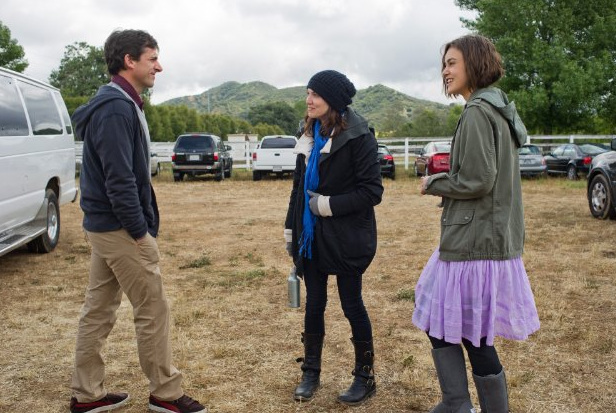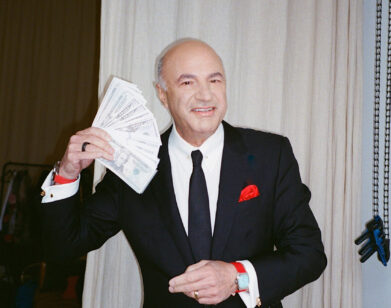Lorene Scafaria: Happily Ever After (Without the Ever After)

ABOVE: STEVE CARELL, LORENE SCAFARIA, AND KEIRA KNIGHTLEY FILMING SEEKING A FRIEND FOR THE END OF THE WORLD. PHOTO COURTESY OF FOCUS FEATURES.
Hollywood has churned out plenty of disaster movies but few have the heart of the new film Seeking a Friend for the End of the World, out this Friday. Marking the directorial debut of Lorene Scafaria, best known for writing Nick and Nora’s Infinite Playlist, the film stars Steve Carell as an insurance salesman named Dodge and Keira Knightley as Penny. The two lonely souls band together on road trip to find Dodge’s lost love and Penny’s family in the weeks before a meteor wipes out life on earth. Even though it’s a film about the end of humanity, Scafaria keeps the film light by peppering Dodge and Penny’s road trip with surreal pit stops such as a suburban dinner party where guests bring heroin and a TGIFriday’s-esque restaurant that has devolved into a permanent rave. While most romantic comedies end with some variation of “happily ever after,” Scafaria’s film examines what happens when “ever after” is taken out of the equation. We caught up with Scafaria to ask about transitioning from screenwriting to directing and why she cast Steve Carell as the straight man.
GILLIAN MOHNEY: Where did the story come from?
LORENE SCAFARIA: I felt like I had been kicking around the idea for a long time. I think I had always been obsessed with these themes of love and death and time more than anything. In the 90’s there were these great end of the world movies like Armageddon and Deep Impact …I always liked the idea of what people on the ground are doing, not so much the people who are trying to stop the world from ending. Then 9/11 happened and I [had] moved from NY to LA a week before… I was so desperate for human contact. I was calling up old friends. I was trying to find an ex-boyfriend. I just thought how strange it is that this huge global event could have tiny little impact on me and my relationships and my behavior with people. That stayed with me for a long time.
MOHNEY: You have an amazing cast, when you wrote the script did you have Steve or Keira in mind?
SCAFARIA: No I don’t really write thinking about specific actors because it can get in the way a little bit. I certainly never imagined that we would get people like this of that caliber. I have always been obsessed with the kind of man who is sleep walking though life. I feel like I’ve written him in various scripts…In all the different incarnations I wanted Steve Carell to play the part and for this in particular because he brings so much humanity to his characters and you really sympathize with him. I pictured him in all of the roles and [kept my] fingers crossed we could even get a read out of him for the script…and Keira is someone who [came on] after we got Steve on board. I was just thinking who would be really exciting to see light a fire under him and have that kind of energy, just like a little firecracker.
MOHNEY: It’s nice to see him as the straight man, while Keira gets to be more of a broader character.
SCAFARIA: Yeah he’s great at everything and he’s so fun at broad comedy in general. [But] it was so fun to put this comedic actor in a much more introverted, quiet, sort of guarded role and then allow for [Keira] to be more of wild child who unlocks him a bit. And to take this great dramatic actress, who we have seen in these icier dramatic period pieces, to put her more in a comic relief role was really fun to watch.
MOHNEY: You have these little vignettes in the movie with great cast members like Connie Britton and Patton Oswalt. What was it like to build up that part of the story?
SCAFARIA: It was fun, it was like building a world…It was sort of like shooting for the stars and I feel like everybody came out because they responded to the idea and were interested in playing out the scenes in the movie and Patton [Oswalt] was someone who showed up just to blow off some steam. He came and did his part and right after he was done he was like ‘I needed that.’ It felt like everybody came to play. I think the cast and the crew we assembled [had a lot of sensitive and deep thinkers and I think it worked out. We had a sort of special guest every two or three days. I can’t believe the supporting cast we got for it.
MOHNEY: It’s a really fun movie, but kind of a heavy subject. What was it like on set?
SCAFARIA: I think the bloopers reel is going to be good. I mean obviously there’s heavier scenes than others but the things like Friendsies [restaurant scene] is just a blast…It was so much fun I feel it’s such a light fun group of people actually and Keira is a doll and Steve is so fun. I think because everybody was on set having a great time hopefully, some of that shines through even in darker moments.
MOHNEY: Now that you’ve tried directing, has your writing been impacted?
SCAFARIA: Yeah, it’s wild. I’m having a much harder time writing now. You know after having that experience, you realize that everything you put on the page is taken literally. I was like “Oh wait you’re really doing this?” It’s a little less freeing now. I’m trying to go back to basics and just be a writer for a little while now.
MOHNEY: You’ve been working steadily in film for a while, but did anything surprise you when you made the jump from screenwriter to director?
SCAFARIA: The process was so interesting. I was so much more afraid that we weren’t making the movie than that we were. [But] writing is so lonely and isolating that the feeling of collaborating with a group of people like that was something I’ve never experienced before…Being on set was a blast and I really felt very comfortable there. Writing is so scary and you have deadlines the next day. Being on set I was actually surprised at how comforted I was being with other people and being outdoors.
MOHNEY: At Cannes last month there were protests about the lack of female directors featured at the festival. Being on the ground and transitioning from writing to directing, do you think that things are shifting so that more women might start directing or is it really a case-by-case basis for projects?
SCAFARIA: I think it’s a case-by-case basis…It’s probably the same as in any other industry in any other part of the world. I don’t know why there is a lower percentage [of female directors, but] I think it’s turning. I’ve been a fan of Sophia Coppola and Nicole Holofcener and now Sarah Polley has her film coming out…Even with people in television it seems like a growing trend, for a lack of a better word—my friend Liz [Meriwether’s] show [New Girl,] when it comes back this fall my friend, Dana [Fox] has her show Ben and Kate the same night, and Mindy Kaling’s show. Those shows are sort of back-to-back and it’s pretty cool to see three show runners and creators to have that powerhouse night of comedy. Hopefully someday we won’t have to be counting.
SEEKING A FRIEND FOR THE END OF THE WORLD IS NOW PLAYING IN THEATERS.






